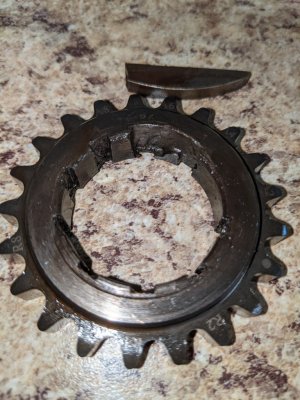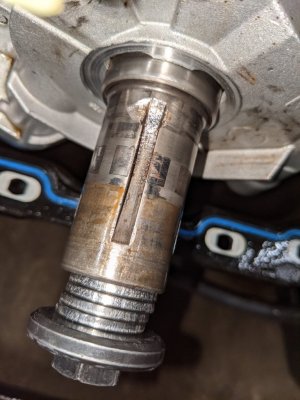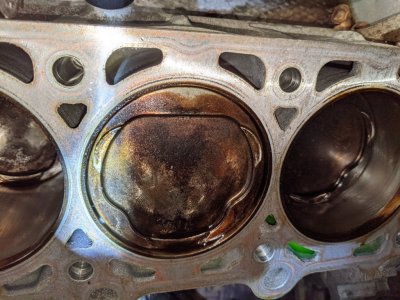Silver'nStripes
Member
Long story short, I was running Hot Rod Drag Week last week. Got a little overzealous with a trailer burnout leaving the first checkpoint and hit the rev limiter in second gear. An hour and a half later we were broken down on the side of the highway.
For context, I'm using an Eagle stroker rotating assembly, custom Bullet cams, TFS adjustable crank sprockets, and an Innovators West 8 rib damper.
After getting home and tearing things apart I discovered a few things.
1. The crank damper bolt was loose, like barely finger tight.
2. The rear cranks sprocket was fairly destroyed and the rear part of the crank key sheared off, so the driver's side camshaft wasn't rotating. The key ways on the other parts of the crank sprocket assembly and crank position reluctor wheel were beat up, but not destroyed.

3. A bit of the crankshaft was broken away where the key sheared off.

4. Evidence of piston to valve contact on the driver's side head, obviously. I consider myself very lucky that no valves broke off and embedded themselves in the pistons.

I'm assuming that the crank damper bolt came loose and that reduction in clamping force allowed everything riding on the crankshaft key to destroy itself. Does this sound plausible? There's also the chance that the crank sprocket broke first and everything got beaten loose.
I'm looking at how to prevent this from happening again. I think the first point is to find an ARP bolt for the crank damper instead of the TTY bolt they provide. And to check that it's tight pretty religiously.
I'm also looking at welding the TFS sprockets this time around. It seems like there has been a lot of back and forth as to if this is necessary, but they seem to be the better option over adjustable camshaft gears.
For context, I'm using an Eagle stroker rotating assembly, custom Bullet cams, TFS adjustable crank sprockets, and an Innovators West 8 rib damper.
After getting home and tearing things apart I discovered a few things.
1. The crank damper bolt was loose, like barely finger tight.
2. The rear cranks sprocket was fairly destroyed and the rear part of the crank key sheared off, so the driver's side camshaft wasn't rotating. The key ways on the other parts of the crank sprocket assembly and crank position reluctor wheel were beat up, but not destroyed.

3. A bit of the crankshaft was broken away where the key sheared off.

4. Evidence of piston to valve contact on the driver's side head, obviously. I consider myself very lucky that no valves broke off and embedded themselves in the pistons.

I'm assuming that the crank damper bolt came loose and that reduction in clamping force allowed everything riding on the crankshaft key to destroy itself. Does this sound plausible? There's also the chance that the crank sprocket broke first and everything got beaten loose.
I'm looking at how to prevent this from happening again. I think the first point is to find an ARP bolt for the crank damper instead of the TTY bolt they provide. And to check that it's tight pretty religiously.
I'm also looking at welding the TFS sprockets this time around. It seems like there has been a lot of back and forth as to if this is necessary, but they seem to be the better option over adjustable camshaft gears.



